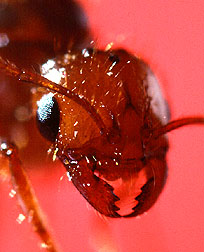
Two Columns
INTRODUCTION
The Autonomic NanoTechnology Swarm (ANTS) is a generic mission architecture consisting of miniaturized, autonomous, self-similar, reconfigurable, addressable components forming structures. The components/structures have wide spatial distribution and multi-level organization. This ‘swarm’ behavior is inspired by the success of social insect colonies where within their specialties, individuals outperform generalists and with sufficiently efficient social interaction and coordination, groups of specialists outperform groups of generalists.
MISSION
The President's Vision for Space Exploration initiated the transformation of NASA's extraordinary capabilities. The goals of the new vision include advancement of U.S. scientific, security, and economic interests through a robust space exploration program which includes the goal of human exploration of planetary surfaces.
The Vision requires innovative multi-function structures, minimal resource use, and development of stand-alone and human-interfaced robotic capabilities. Our team has responded by developing ART (Addressable Reconfigurable Technology), as near-term Tetrahedral Walkers and Manipulators for lunar reconnaissance (ALMA/ALI) and as a more advanced mobile infrastructure for lunar exploration and exploitation (LARA) with applicability wherever extreme mobility is required on Earth.
Future ART structures will be capable of true autonomy using bilevel intelligence combining autonomic and heuristic aspects, acting as part of an Autonomous NanoTechnology Swarm (ANTS).
ARCHITECTURE
The Autonomous NanoTechnology Swarm (ANTS) Architecture is well suited to remote space or ground operations. It is being implemented on a near term basis, using Addressable Reconfigurable Technology (ART). In the future, Super Miniaturized ART (SMART) will form highly reconfigurable networks of struts, acting as 3D mesh or 2D fabric to perform a range of functions on demand. The ANTS approach harnesses the effective skeletal/ muscular system of the frame itself to enable amoeboid movement, effectively ‘flowing’ between morphological forms. ANTS structures would thus be capable of forming an en tire mobile modular infrastructure adapted to its environment.
The ANTS architecture is inspired by the success of social insect colonies, a success based on the division of labor within the colony in two key ways: First, within their specialties, individual specialists generally outperform generalists. Second, with sufficiently efficient social interaction and coordination, the group of specialists generally outperforms the group of generalists. Thus systems designed as ANTS arebuilt from potentially very large numbers of highly autonomous, yet socially interactive, elements. The architecture is self-similar in that elements and sub-elements of the system may also be recursively structured as ANTS on scales ranging from microscopic to interplanetary distances.
ARTIFICIAL INTELLIGENCE

In order for robots to be considered ‘intelligent’, they must be able to learn about their world and develop their own ability to interact with it. To date, work in artificial intelligence has gone in the direction of programming heuristic, highly symbolic, decision making ability (higher level intelligence), or developing hardware that responds autonomically to its environment (lower level intelligence). High-level approaches are resource-intensive, expensive, heavily symbolic, and thus often face problems in real-world problem-solving. Low-level dynamical control or reactive approaches are developed for particular tasks and thus lack an innate connection to any higher-level purpose. Researchers at NASA Goddard Space Flight Center are developing a new approach to realizing autonomous artificially intelligent systems: a software construct called a neural basis function (NBF) to bridge the divide between lower and higher level functions and create bilevel intelligence capably of ‘truly’ autonomous behavior. NBFs will greatly simplify the process of developing autonomous remote systems. A Lower Level Neural System (LLNS) provides for elementary system function, security, and safety, while a Higher Level Neural System (HLNS) provides more purposeful behavior such as problem solving, planning, scheduling to achieve goals. These two systems interact via a third system, an Evolvable Neural Interface (ENI) that allows the AI system to be situated in a real world context.
Autonomous NanoTechnology Swarm
ANTS Fact
Unlike any other rover, the TET walker is designed to roll over.
